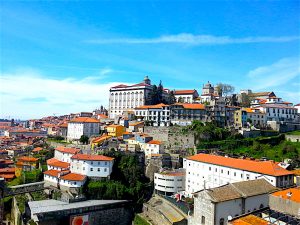Porto, Portugal’s second city, was founded in Roman times, but came into its own during the Versailles Century.

Porto’s historic heart with the cathedral and archbishop’s palace on the hilltop.
Brazilian gold flowing across the Atlantic after the discovery of the precious yellow metal in Minas Gerais in the 1690s, combined with the boom in the port wine trade after the signing of the Methuen Treaty with Great Britain in 1703, made Porto rich. Much of the loot was spent on spectacular churches. Modern visitors to the city will find the built heritage of the northern Portuguese Baroque all around them. The star exhibits are the buildings designed by the transplant Nicolau Nasoni (1691-1773), an all-around talent who arrived from Italy to execute some paintings for the archbishop and stayed for the rest of his life, undertaking not only paintings, but interior design and architecture.














